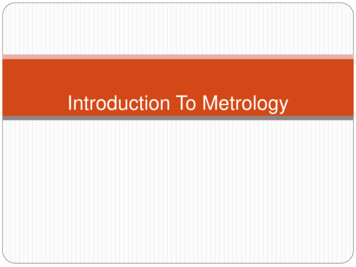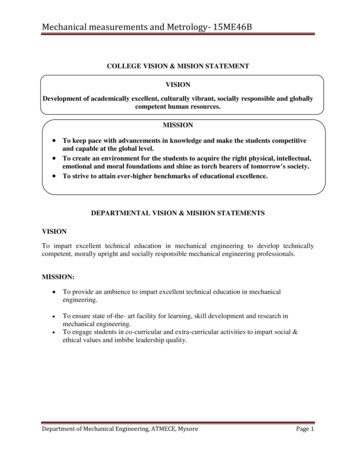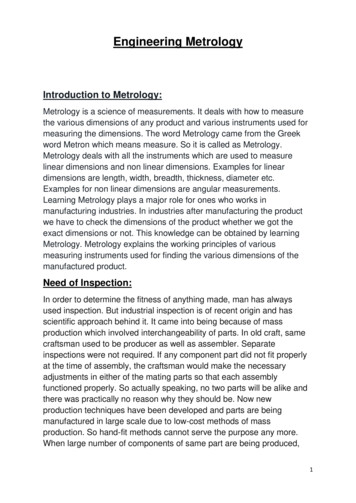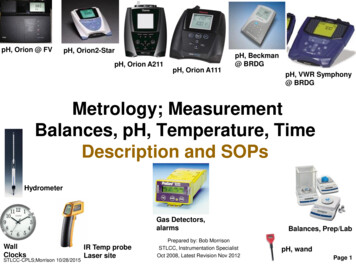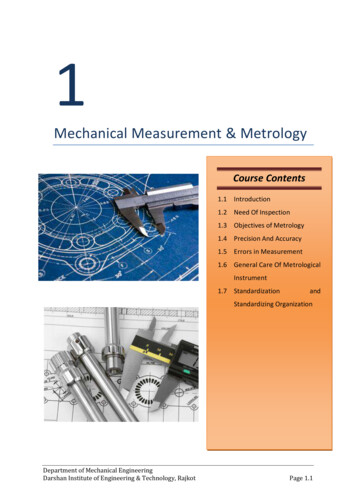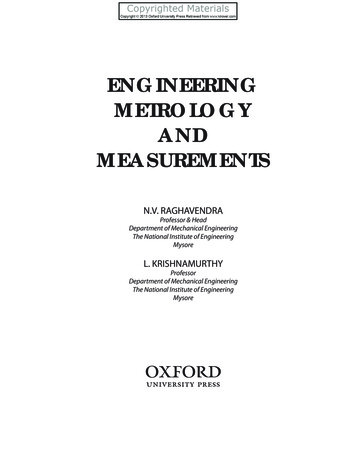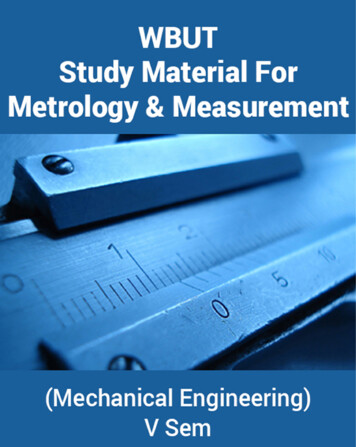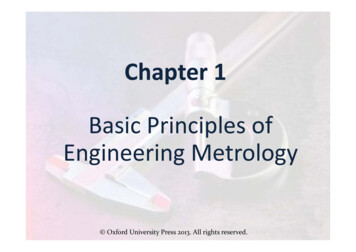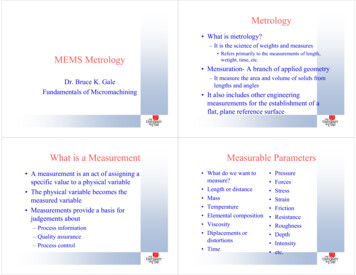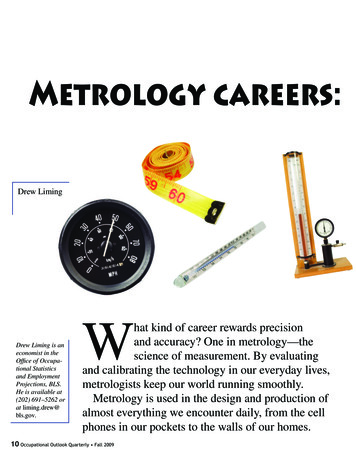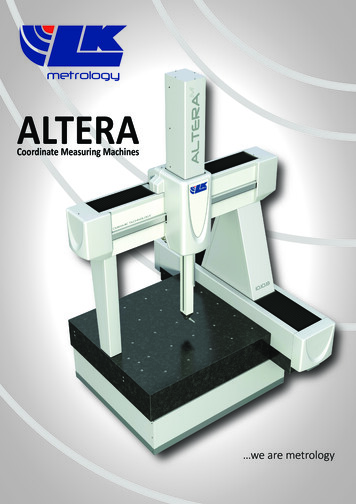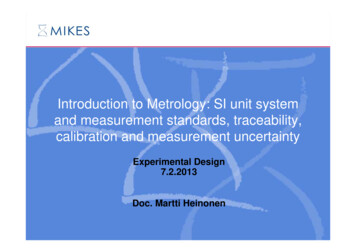
Transcription
Introduction to Metrology: SI unit systemand measurement standards, traceability,calibration and measurement uncertaintyExperimental Design7.2.2013Doc. Martti Heinonen
Mars Climate OrbiterMH 20132
Impact of metrology: NIST SRM caseMH 20133
Outline1.Traceability in measurements1.1 Basic concepts1.2 Why we need traceability?1.3 Infrastructure ensuring availability of traceablemeasurements2. SI – the international system of units2.1 System of units: from trade to science2.2 Base and derived units2.3 Measurement standards and traceability3.Measurement uncertainty – part 1: Introduction3.1 Terminology3.2 Importance of the measurement uncertainty4.Measurement uncertainty – part 2: Methods4.1 Calculating uncertainty4.2 Calculations step by step4.3 Uncertainty calculation in practiceMH 20134
1 Traceability in measurements1.1 Basic concepts1.2 Why we need traceability?1.3 Infrastructure ensuring availability of traceablemeasurements
1.1 Basic concepts
TermsQUANTITY Property of a phenomenon, body, or substance, where the property has amagnitude that can be expressed as a number and a reference(A reference can be a measurement unit, a measurement procedure, a referencematerial, or a combination of such.) Quantity can be a general quantity (e.g. length) or particular quantity (e.g.wavelength of Sodium D line)MEASURAND Quantity intended to be measuredESTIMATE (of the measurand); called also MEASURED QUANTITY VALUE measured value of a quantity measured value quantity value representing a measurement resultMEASUREMENT ERROR measured quantity value minus a reference quantity valueMH 20137
Metrology (metrologia)metrology is:science of measurement andits applicationsystem ationof the units[1.1, 1.2]Metrology includes all theoreticaland practical aspects ofmeasurement, whatever themeasurement uncertainty andfield of application.definitions ofthe SI unitsdisseminationof units bytraceablecalibrationsmeasurementsfor trade- legal metrologyapplied traceablemeasurements- for industrialproductionMH 20138
Metrology (metrologia)Usually the concept of metrology is limited to: Science of measurement studying the relationshipbetween measurands and their estimates (measuredquantity values)MH 20139
Uncertainty of measurement (epävarmuus)non-negative parametercharacterizing the dispersion ofthe quantity values beingattributed to a measurand,based on the information used 1σ 2σr 2u95%r urr-ur – 2u68%[1.1, 1.2]r estimate mean valueu standard uncertaintyMH 201310
Facts about Measurement Results Usually a measurement disturbs its target affecting thus themeasurement result. A measurement result is always a combination of many factors.(reading or output signal of the measuring device is only one of them) We never know all the factors. We never know the “true value” of the factors(we can only estimate). The combined effect of unknown factors and inaccurateknowledge on the known factors is described quantitatively withthe measurement uncertainty. “Absolute certainty is the privilege of uneducated minds . orfanatics.”MH 201311
Accuracy and Precisionaccuracy (tarkkuus)closeness of agreement between ameasured quantity value and a truequantity value of a measurandprecision (täsmällisyys)closeness of agreement betweenindications or measured quantityvalues obtained by replicatemeasurements on the same or similarobjects under specified conditions[1.1, 1.2]MH 201312
Calibration (kalibrointi)operation that, under specified conditions, in a first step, establishes a relationbetween the quantity values with measurement uncertainties provided bymeasurement standards and corresponding indications with associatedmeasurement uncertainties and, in a second step, uses this information toestablish a relation for obtaining a measurement result from an indication. [1.1, 1.2]The result of a calibration can be given as correction value(s) at discrete measurement point(s) calibration equation (curve) re-calculated constant(s) statement that the error is in given specifications.A calibration result includes always the uncertainty.(also the probability level should be given)Conditions of calibration should be stated when reporting calibration results.MH 201313
Adjustment (viritys)set of operations carried out on a measuring system so that it providesprescribed indications corresponding to given values of a quantity to bemeasured [1.1, 1.2]NOTE 1: Types of adjustment of a measuring system include zero adjustment of a measuringsystem, offset adjustment, and span adjustment (sometimes called gain adjustment).NOTE 2: Adjustment of a measuring system should not be confused with calibration, which is aprerequisite for adjustment.NOTE 3: After an adjustment of a measuring system, the measuring system must usually berecalibrated.MH 201314
SI – System of unitsTraceability (jäljitettävyys)Definition of theunitRealization of the unit:National measurementstandardMetre conventionNational MetrologyInstitute / erencemeasurement standardmeasurement standardAccredited laboratoryWorking measurementstandardIndustrial laboratoryTraceablemeasurementEnd userExample of traceability chain(Metrological traceability)property of a measurement resultwhereby the result can be related to areference through a documentedunbroken chain of calibrations, eachcontributing to the measurementuncertaintyTraceability chain:sequence of measurement standards andcalibrations that is used to relate ameasurement result to a reference[1.1, 1.2]MH 201315
SI – System of unitsTraceability (jäljitettävyys)Definition of theunitRealization of the unit:National measurementstandardMetre conventionNational MetrologyInstitute / erencemeasurement standardmeasurement standardAccredited laboratoryWorking measurementstandardIndustrial laboratoryTraceablemeasurementTraceability Evidence thatyour unit is of the same size asthe internationally acceptedone.End userExample of traceability chainMH 201316
Measurement standard (mittanormaali) realization of a given quantity, with stated quantity valueand associated measurement uncertainty, used as areference Measurement standard can be an instrument, ameasuring system, material measure or a referencematerial.[1.2]MH 201317
Characteristics of Unbroken TraceabilityFor each calibration of the chain: Uncertainty estimation Documented and generally acknowledged procedures,documented results Competence Calibration is valid for the application.(interval of calibrations, conditions etc.)PUVCSI – System of UnitsMH 201318
Traceability TowerKCDUKCMeasuring instrumentDUKCDUKCDUKCDUKCCalibration standardReference standardSecondary standardPrimary standard Measurement uncertaintyDUMeasurementThe tower is collapsed if anypart of it is missing orincompletei.e.there is no traceability unless alllevels include all thecharacteristics of traceability At any level the measurementuncertainty can t be smallerthan levels below.SI – System of UnitsMH 201319
Typical problems in traceabilityNo calibrationCalibration resultshave not beenusedCalibration intervaltoo longCalibration coversonly a part of themeasuring systemNo evidence on thetraceability incalibrationIncomplete traceability chain no traceabilityCalibration wascarried out inconditions toodifferent from theapplicationUThere is no evidenceon the traceabilityof the refencematerialsMeasurementPCMH 201320
1.2 Why we need traceability?
Traceability – why? Modern industrial production is notpossible if subcontractors havedifferent scales Scientific technical research can notnecessarily be repeated if it is donewithout traceably calibratedinstruments Traceability is the answer to thequestions: From where can I find a reliablemeasurement standard? How can I convince others of thereliability of my measurementstandard?MH 201322
Traceability – why?Examples: Pharmaceutics Telecommunication Aviation Space technology Safety: Nuclear power plantMH 201323
Source: DTI UKMH 201324
1.3Infrastructure ensuring availabilityof traceable measurements
Metrology Infrastructure for ensuring global availability of traceable measurements foundation: The Metre Convention – a diplomatic treatyfirst signed in 1875 by representatives of 17 nations three levels: Global Regional NationalMH 201326
Global:Finnish members:1953-1971 Yrjö Väisälä1992-1998 Olli LounasmaaMIKES is a member of:- CC for Length,- CC for Electricity andMagnetism- CC for Thermometry- CC for Photometry andRadiometryMH 201327
Regional:AFRIMETMH 201328
National:MH 201329
Impact of metrology:Finnish numbersNational MetrologyInstitute (MIKES)andDesignated Institutes(STUK, GL, Aalto,FMI, SYKE)Approximate amount oftraceable calibration and testingcertificates issued annually andtraceable instruments/measurements Accreditedcalibration labs 30Calibrations andmeasurementsin industryAccreditedtesting labs. 2002000 20 000kplMeasurementsMeasurements inby governmental andresearch institutescommunal institutionsMeasurements in trade and safety(Legal metroloy) 2 000 000 2000 000 000 (00?)MH 201330
CIPM MRA objectives: to establish the degree ofequivalence of measurementstandards maintained by NMIs; to provide for the mutual recognitionof calibration and measurementcertificates issued by NMIs; therebyto to provide governments and otherparties with a secure technicalfoundation for wider agreementsrelated to international trade,commerce and regulatory affairsMRA has been signed by 67 NMIs from45 states and 20 associate statesMRA includes database of NMIsreviewed calibration services withcorresonding uncertainties (CMCs)MIKES has several 100s of differentCMC entriesMH 201331
2 SI – the international system of units2.1 System of units: from trade to science2.2 Base and derived units2.3 Unit realisations and measurement standards
2.1 A system of units: from trade to scienceArchimedes Thoughtful by Domenico Fetti (1620)[wikipedia]MH 201333
SI – system for characterizing physicaland chemical phenomenaspeed:v ΔxΔtΔx(Δt ) 2(Δx) 2E FΔx m(Δt ) 2F ma mforce:energy:power:F m(Δx) 2P Δt (Δt ) 3pressure:p FmΔx A (Δt ) 2 l 2density:ρ m m V l3MH 201334
SI – system for characterizing physicaland chemical phenomenafor real gas:p gV ng RTZ g ( p, T )rotating speed:ω nΔtthermal expansion: Δl lαΔTfrequency:resistance:Electr. power:illuminance:n 1 Δt τUR If P U IEv F I vΩ AAC12H26(l) 37/2 O2(g) 12 CO2(g) 13 H2O(g)MH 201335
2.2Base and derived units
SI system – properties based on a set of 7 base units by convention these are assumed to be independent other units are formed as products of powers from base units(derived units) some derived units have special names like Newton system is coherent i.e.equations between the numerical values of quantities takeexactly the same form as the equations between the quantitiesthemselves decimal system is usedMH 201337
SI system – Base units[2.1]MH 201338
Definitions of base units Kilogram:The kilogram is the unit of mass; it is equal to themass of the international prototype of the kilogram. Metre:The metre is the length of the path travelled bylight in vacuum during a time interval of 1/299 792458 of a second. Second:The second is the duration of 9 192 631 770periods of the radiation corresponding to thetransition between the two hyperfine levels of theground state of the caesium 133 atom.MH 201339
Definitions of base units Kelvin:The kelvin, unit of thermodynamic temperature, isthe fraction 1/273.16 of the thermodynamictemperature of the triple point of water. Mole:The mole is the amount of substance of a systemwhich contains as many elementary entities asthere are atoms in 0.012 kilogram of carbon 12. When the mole is used, the elementary entitiesmust be specified and may be atoms, molecules,ions, electrons, other particles, or specified groupsof such particles.MH 201340
Definitions of base units Ampere:The ampere is that constant current which, if maintained in two straightparallel conductors of infinite length, of negligible circular cross-section,and placed 1 metre apart in vacuum, would produce between theseconductors a force equal to 2 10-7 newton per metre of length. NOTE 1: Direct realisation of the SI ampere is very difficult in practice NOTE 2: N kg · m · s-2 Depends on the prototype of kg Candela:The candela is the luminous intensity, in a given direction, of a source thatemits monochromatic radiation of frequency540 x 1012 hertz and that has a radiant intensity in that direction of 1/683watt per steradian.MH 201341
Need for redefining SI base units Drawbacks of the current SI are: Kilogram is defined with an artefact The definition of kelvin is based on material properties The definition of ampere limits the achievable accuracy andis not currently use (quantum standards of ohm and voltageare used instead through the Ohm’s law) Because of these, drift, non-uniqueness and limitations inaccuracy cannot completely be prevented.MH 201342
SI base units in futureGround state hyperfine splitting frequency of thecaesium 133 atomSpeed of light in vacuumAvogadro constantBoltzmann constantPlanck constantElementary chargeLuminous efficacyMH 201343
SI system – Derived units[2.1]MH 201344
SI system – Derived units with special names[2.1]MH 201345
SI system – Derived units with special names 2[2.1]MH 201346
Realisation of a derived unit The realisation forms a link between the measurements of aderived quantity and the SI base units. Characteristics of the realisation: Based on the definition of the quantity Measurements in terms of SI units (base or derived but not of thesame quantity) with traceability to national/internationalmeasurement standards Full uncertainty analysis Comparisons to other realisations of the same quantity National Standards Laboratories maintain realisations (orsecondary standards) for a set of derived quantitiesMH 201347
Realisation of the pascal Unit with a special name: 1 Pa 1 m-1 kg s-2Definition of pressure:pistonRealisation of the unit:Fp AForce lifting the piston F1:F1 pAcylinderForce lowering the piston F2:F2 mgIn equilibrium:Pressure balancemgF1 F2 p AMH 201348
Realisation of the unit of the dew-pointtemperature (K or C) Same unit as of the temperature but different meaning:Dew-point temperature (td):The temperature at which the gas would be saturated withrespect to a plane surface of pure liquid water or solid ice at thesame gas pressure.A saturator-based primary humidity standardAir or other gas is saturated with respect to plane water or ice surface: dew-point temperature (td) air/gas temperature in the saturator (ts)Saturated air/gas passes throughinternally polished stainless steeltubing .td ts ttubingRH 100 %td tsRH 100%td ts ΔtdP tchamberRH RH(td,tchamber)The air or gas enters a measurement chamber.Humidity in the chamber is determined by the temperaturesand pressures of the saturator and the chamberMH 201349
2.3Measurement standards andtraceability
Traceability in chemical measurementsSI unit: moleThe mole was added to SI in 1971.Chemical primary methods Isotope Dilution Mass SpectrometryGravimetryTitrimetryCoulometryFreezing Point Depression (Differential Scanning Calorimetry)Certified reference materialsISO Guides 30 – 35, 1989 - 2000Validated measurement methods andreference materials in laboratoriesMH 201351
Traceability to altitude measurements in amilitary ng instrumentPrimary standardSI – System of UnitsAltimeter 10 mThe pressure simulator of the brigade 30 Pa 2.6 mK013 pressure working standard 20 Pa 1.7 mK013 pressure reference standard 10 Pa 0.9 mMIKES Primary Pressure StandardMIKES Primary Mass and Length StandardsMH 201352
3 Measurement uncertainty – part 1:Introduction3.1 Terminology3.2 Importance of the measurement uncertainty
3.1 Terminology
TermsMEASUREMENT REPEATABILITY measurement precision under a set of repeatability (similar) conditionsof measurementMEASUREMENT REPRODUCIBILITY measurement precision under reproducibility (changed) conditions ofmeasurementRANDOM ERROR Component of measurement error that in replicate measurementsvaries in an unpredictable mannerSYSTEMATIC ERROR Component of measurement error that in replicate measurementsremains constant or varies in a predictable manner[1.1, 1.2]MH 201355
3.2 Importance of the measurementuncertainty
Measurement result and its uncertainty Estimated quality of a result is expressed as the uncertainty The uncertainty is an essential part of a measurement result:Measurement result Estimate uncertainty The uncertainty gives the limits of the range in which the “true”value of the measurand is estimated to be at a given probability. Too often the uncertainty is not presented explicitly with theestimate confusion, incorrect conclusions, non-equal users etc. If the uncertainty is not taken into account, incorrect conclusionsare drawn and the number of unsatisfactory products increases. When you know the uncertainty in a measurement, then you canjudge its fitness for purpose.MH 201357
Importance of uncertainty of measurements Measurements are never absolutely accurate, but there isalways some uncertainty in the measured values. Measurement result without uncertainty estimate ismeaningless. Estimation of measurement uncertainties is one of the mostimportant parts of practical metrology. A proper uncertainty budget indicates what parts of themeasurement should be developed to decrease the overalluncertainty most effectively.MH 201358
Certified range [U k ·u c (k 2)]: 1.226 - 1.294 01.3301.23-101.131.03-200.93-300.830.73-409 valuesbelow -50%0.63Deviation from middle of certified range in %503 valuesabove 50%-50Results from all participants.[Mittaustulosten epävarmuus, MIKES 26.6.2005]MH 201359
4 Measurement uncertainty – part 2:Methods4.1 Calculating uncertainty4.2 Calculations step by step4.3 Uncertainty calculation in practice
4.1 Calculating uncertainty
Calculating a measurement result A measurement result is calculated from input data. In additionto the measurement values, the data often include informationfrom earlier measurements, specifications, calibrationcertificates etc. The calculation method is described with an equation (or a setof equations) called measurement model (mathematical model) The model is used for both calculation of the estimate and theuncertainty of the results. The model should include all factors (input quantities) affectingsignificantly the estimate and/or the uncertainty. The model is never complete; approximations are needed.MH 201362
6 steps to evaluating uncertainty1) Measurement model:List essential input quantities (i.e. parameters xi having a significanteffect on the result) and build up a mathematical model (function)showing how they are related to the final result: y f(x1,, , xi)2) Standard uncertainty:Estimate the standard uncertainty of each input quantity (xi)3) Using the model in uncertainty calculations:Determine the uncertainty due to standard uncertainty of each inputquantity (xi).4) Correlation:Determine correlation between the input quantities (if relevant)5) Calculate the combined standard uncertainty6) Calculate the expanded uncertainty.MH 201363
4.2 Calculations step by stepStep 1: Measurement modelStep 2: Standard uncertaintyType A evaluation of standard uncertaintyType B evaluation of standard uncertaintyStep 3:Using the model in uncertainty calculationsStep 4: CorrelationStep 5: Combining the uncertainty componentsStep 6: Expanded uncertainty
Step 1: Measurement modelEquation which describes the measurement:MeasurandY f ( X 1,X 2 ,.,X n )Input quantities Xi The model should include:Measurement results, corrections, reference values, influence quantities. The magnitude of a correction can be zero but it can still have uncertainty The values and uncertainties of the input quantities should be determinedMeasurement result (y) is:y f ( x1,x2 ,.,xn ) xi is the value (estimate) of the input quantity XiExample :t x tind δtCal δt D δt resol δtGMH 201365
Step 2: Standard uncertainty All uncertainty components should be comparable standarduncertainty ui The variance of the sum of non-correlating random variables is the sumof their variances standard uncertainty is the square root of variance all uncertainty components should be expressed as standardsuncertainties For normal distribution standard uncertaintycorresponds to about 68%confidence levelMH 201366
Two methods for estimating the standarduncertainty of an input quantity Type A: Evaluated from a number of observations (usually 10) Tyyppi B: Evaluated from a single (or a small number of) data value(s) Often taken from data reported earlier or by othersMH 201367
Type A evaluation of standard uncertainty Uncertainty is evaluated by statistical analysis of a series of observations qi The spread of the results is assumed to be random1 nq qin i 1 An estimate for the value of the quantityis the arithmetic mean q An estimate for the variance of the probability distribution is s(x)2:1 n2()s (q) q q in 1 i 1 s(q) is termed the experimental standarddeviation22 An estimate for the variance of the mean s (q)(the experimental variance of the mean) is: The standard uncertainty of q equals theexperimental standard deviation of the mean:s 2 (q)s (q) n2n1u (q ) s(q) (qi q) 2 n(n 1) i 1If type A measurement uncertainty is based on few measurements the estimation of u(x)is not reliable and normal distribution can not be assumed.(unless other information on the distribution is available)MH 201368
Type B evaluation of standard uncertainty To be applied for estimates of input quantities that has not been obtained fromrepeated measurements Typical examples : uncertainties of values and drifts of reference standards uncertainties of environmental quantities uncertainties from specifications of instrument uncertainties from literature values uncertainty due to the method or calculation uncertainty due to staff uncertainties from calibration certificatesMH 201369
Rectangular distributionuncertainty distribution p All values in the range xi - a xi a have equal probability Standard uncertaintyu ( xi ) Examples: specifications, resolutiona 0,577a3 Applied if only limiting values are knownMH 201370
Triangular distributionxi - axi a Example: convolution of two rectangular distribution Standard uncertainty:u ( xi ) a 0,408 a6MH 201371
U-shape distribution2.50-101xi – axi a Example: sinusoidal variation between limits a Standard uncertainty:u ( xi ) a 0,707 a2MH 201372
Step 3:Using the model in uncertainty calculations The contribution of u(xi) to the uncertainty of y is determined bythe sensitivity coefficient ci The sensitivity coefficient can be determined from partial derivative of f(X1, X2, ,Xn) with Xii.e. ci f / Xi (at x1, x2, ,xn) by numerical methods ci Δy / Δxi experimentally by changing xi by Δxi and determining Δy ;ci Δy / Δxi The contribution of u(xi) to the uncertainty of y is:ui(y) ci u(xi)MH 201373
Step4: Correlation The covariance u(xi,xj) of two random variables is a measure of theirmutual dependence. If Xi F(Ql) and Xj G(Ql) depend on the same quantities Ql (l 1.n) F G 2thenu ( xi , x j ) u (ql )i ql ql Correlation coefficient :r ( xi , x j ) u ( xi , x j )u ( xi )u ( x j ) The covariance can increase or decrease uncertainty. If the correlation coefficient is r 1 the components will be added in alinear way.MH 201374
Step 5: Combining the uncertainty components Uncorrelated input quantities:2 δf 2 u ( xi )uc ( y ) u ( yi ) i 1i 1 δxi N 2iNCorrelated input quantities:2N 1 N δf 2δf δf u ( xi ) 2 u ( xi , x j )uc ( y ) i 1 δxi i 1 j i 1δxi δx jNuc(y) combined standard uncertainty; u(xi,xj) covarianceMH 201375
Step 6: Expanded uncertaintyOften the result of the measurement is reported with a higher level ofconfidence than given by the standard uncertainty. Expanded uncertainty U is the standard uncertainty multiplied by a coveragefactor k:U kuc (y) In calibration it is recommended to report 95 % level of confidence. For normal distribution this corresponds to k 2 (approximately).Normaldistribution:Coverage probabilityp68,27 %90 %95 %95,45%99 %99,73%Coverage factork1,001,651,962,002,583,00MH 201376
Normal distribution 1σ 2σMeasurement result is approximately normally distributed if- it is a combination of several random variables (independent of distribution)- none of the (non-normally distributed) components is dominating.MH 201377
Degrees of freedom and the coverage factor For a combined standard uncertainty, we can calculate the 4u ( y)effective number of degrees of freedom (νeff) :ν eff The figure shows that we need a coverage factorlarger than 2 to obtain 95 % confidence level if thenumber of degrees of freedom is small.N i 1u 4 ( xi )νip 95,45 % ; 2σ54,5Coverage 0lkmof freedomNumberVapausasteidenof effective degreesMH 201378
4.2 Uncertainty calculation in practice
Example: Measurement of SO2 content An analyzer with electrical current signal output was used formeasuring SO2 content in exhaust gas. The signal was measured with a DMM and the total error in thecurrent measurement was estimated to be within 0,1 mA. The arithmetic mean of the 15 recorded DMM readings is9,59mA and the corresponding standard deviation is 0,49 mA. An accredited laboratory has determined the calibration functionfor the analyzer:3mg/mfc (I m ) 7,64 mg/m 3 3,25 ImmAThe reported expanded uncertainty (k 2) is 6 mg/m3 When comparing two last calibrations, we can conclude that thedrift of the analyzer is less than 5 mg/m3/year (calibr. interval is1 year)MH 201380
Example: Measurement of SO2 content - continuing The measurement result is calculated as follows:CSO 2 f c ( I m δI m ) δf c δ Drift3mg/m 7,64 mg/m3 3,25 ( I m δI m ) δf c δ DriftmA The variables can be assumed independent on eachother; therefore we can calculate the uncertainty:u (CSO 2 ) [c1u ( I m )]2 [c2u (δI m )]2 [c3u (δf c )]2 [c4u (δ Drift )]2MH 201381
Example: Measurement of SO2 content - continuing The sensitivity coefficients are: CSO 2mg/m3c1 3,25 I mmA CSO 2c2 c1 δI m CSO 2 CSO 2 c4 1c3 δf c δ Drift Thus:u (CSO 2 ) c1 [u 2 ( I m ) u 2 (δI m )] u 2 (δf c ) u 2 (δ Drift )2MH 201382
Example: Measurement of SO2 content - continuing Standard uncertainties of the components:u ( I m ) 0,49 mAtype A, normal distribution0,1 mAtype B, rectangular distribution 0,06 mA36 mg/m3type B, normal distributionu (δf c ) 3 mg/m 325 mg/m 3u (δ Drift ) 2,9 mg/m 3 type B, rectangular distribution3u (δI m ) MH 201383
Example: Measurement of SO2 content - continuing Estimate for the SO2 content:mg/m3CSO 2 7,64 mg/m 3,25 (9,59 mA 0 mA) 0 mg/m 3 0 mg/m3mA 23,5 mg/m 33 and its combined standard uncertainty:2 mg/m 3 (0,49 mA)2 (0,06 mA)2 (3 mg/m 3 ) 2 (2,9 mg/m 3 ) 2u (CSO 2 ) 3,25mA [] 4,5 mg/m 3MH 201384
Example: Measurement of SO2 content - continuing Thus the expanded uncertainty at about 95 % confidencelevel (k 2) is:U k u 2 4,5 mg/m3 9,0 mg/m3 As a conclusion, the measurement result is :CSO2 (24 9) mg/m3MH 201385
References and literature[1.1] ISO/IEC Guide 99-12:2007, International Vocabulary of Metrology — Basic and General Concepts andAssociated Terms, VIM[1.2] International vocabulary of metrology — Basic and general concepts and associated terms (VIM), 3rd ed.,JCGM 200:2008(can be downloaded at http://www.bipm.org/en/publications/guides/)[2.1] http://www.bipm.org/en/si/si brochure/Metrology - in short, 3rd edition, EURAMET 2008, 84 p. (www.euramet.org)Literature about estimating uncertainty: Guide to the Expression of Uncertainty in Measurement. International Organization for Standardization,Geneva, Swizerland. ISBN 92-67-10188-9, First Edition, 1993. JCGM 100:2008, Evaluation of measurement data – Guide to the expression of uncertainty inmeasurement, First edition, JCGM 2008 (http://www.bipm.org/en/publications/guides/) European cooperation for Accreditation, EA-4/02 Expression of the Uncertainty of Measurement inCalibration, 1999. -02.pdf) UKAS M3003, The Expression of Uncertainty and Confidence in Measurement EURACHEM/CITAC Guide CG 4, Quantifying Uncertainty in Analytical mu/QUAM2000-1.pdf) S. A. Bell, A beginner's guide to uncertainty in measurement, Measurement Good Practice Guide No. 11 ,(Issue 2), National Physical Laboratory 2001, 41 p. (www.npl.co.uk)MIKES has published several guides in Finnish on the uncertainty estimations in different fields.MH 201386
Metrology (metrologia) metrology is: science of measurement and its application [1.1, 1.2] Metrology includes all theoretical and practical aspects of measurement, whatever the measurement uncertainty and field of application. definitions of the SI units system of fundamental constants dissem
